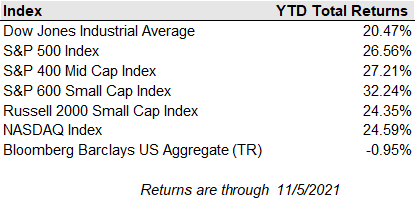Major stock indexes moved to record highs Friday following a strong jobs report that showed 531,000 jobs added in October and a revised gain of 312,000 in September. US unemployment fell from 4.8% to 4.6%, representing the first full month of hiring after enhanced unemployment benefits expired. All three major market indexes closed at new all-time highs, even after a late drop in tech stocks weighed on the final Nasdaq number. For the week, the S&P 500 gained 2%, the Dow climbed 1.4%, and the Nasdaq rallied 3.1% for its best weekly showing since April.
Stocks continued their move higher following a telegraphed move by the Fed to wind down its pandemic-era bond purchases. The central bank will cut its monthly Treasury purchases by $10B and mortgage-backed securities by $5B each month, bringing an end to the program in mid-2022. Fed Chair Powell highlighted that tapering doesn't mean policymakers will hike interest rates any time soon. He also held to the belief that high inflation would prove "transitory," and would not likely require a rapid change in policy. An accompanying statement hedged that risk by warning that supply chain imbalances have meant "sizable price increases in some sectors," though Fed will continue to be "patient" and "monetary policy will continue to provide strong support to the economic recovery.” This taper was probably the best telegraphed or advertised move in monetary policy history. Some economists think that even if central banks tighten policy sooner rather than later, the effects could fail to push real yields higher, if the market assumes that it's not enough to catch up with inflation. Much of the inflation being felt in the economy is from transportation issues and supply shortages, so raising rates may not help that front. What they could do is hit the brakes on the demand side, but depending on who is talking, that could risk damaging the economic recovery or prevent it from overheating.
The U.S. ended the international travel ban that was put in place in early 2020, and later expanded early this year. Visitors are now able to fly into the U.S. with proof of full vaccination, and there are some exemptions for travelers under the age of 18 and passengers from countries with low vaccination availability. International travel recovery is a bullish sign for an economic recovery from the pandemic.


